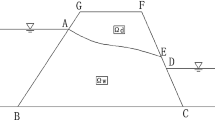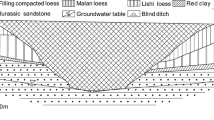Abstract
The disasters caused by groundwater during underground cavern excavation, are inevitable and difficult to predict. In this study, transient seepage analysis was performed during the excavation of Qingyuan power station’s underground caverns and drainage hole arrays. The drainage hole arrays around the caverns were simulated using a new method, and the groundwater surface during transient seepage analysis was confirmed with the hydraulic conductivity adjustment method, by using ABAQUS user subroutines USDFLD and GETVRM. By simplifying the drainage hole into face geometry, the proposed drainage hole simulation method could reach the accuracy of the widely used substructure method with half nodes of the computational boundary, and reflect the influence of drainage hole diameter on seepage analysis results. Moreover, a sensibility analysis of the diameter and space of drainage hole arrays could be conducted using one simulation model with the proposed finite element mesh type. Transient seepage analysis showed the evolutions of the groundwater level, flow rate and maximum hydraulic gradient of drainage holes and underground caverns, during the construction of Qingyuan power station. Such results could provide a reference for the creation of design and construction schemes. The previous excavation of the drainage hole arrays could control the seepage field, and reduce the flow rate and maximum hydraulic gradient of the underground caverns. This study may provide valuable reference to the design and construction of similar projects.




















Similar content being viewed by others
Availability of Data and Material
All data generated or used in this study appear in the published article.
Code Availability
Not.
References
Cao, C.; Xu, Z.G.; Chai, J.R.; Qin, Y.; Cao, J.: Determination method for influence zone of pumped storage underground cavern and drainage system. J. Hydrol. (2021). https://doi.org/10.1016/j.jhydrol.2021.126018
Cao, C.; Xu, Z.G.; Chai, J.R.; Li, Y.Q.: Radial fluid flow regime in a single fracture under high hydraulic pressure during shear process. J. Hydrol. 579, 124142 (2019)
Cao, C.; Xu, Z.G.; Chai, J.R.; Yuan, Q.; Tan, R.: Mechanical and hydraulic behaviors in a single fracture with asperities crushed during shear. Int. J. Geomech. 18(11), 04018148 (2018)
Xu, Z.G.; Cao, C.; Li, K.H.; Chai, J.R.; Xiong, W.; Zhao, J.Y.; Qin, R.G.: Simulation of drainage hole arrays and seepage control analysis of the Qingyuan Pumped Storage Power Station in China: a case study. Bull. Eng. Geol. Environ. 78(8), 6335–6346 (2019)
Li, Y.; Chen, Y.F.; Jiang, Q.H.; Hu, R.; Zhou, C.B.: Performance assessment and optimization of seepage control system: a numerical case study for Kala underground powerhouse. Comput. Geotech. 55, 306–315 (2014)
Fattahi, H.; Shojaee, S.; Farsangi, M.A.W.; Mansouri, H.: Hybrid Monte Carlo simulation and ANFIS-subtractive clustering method for reliability analysis of the excavation damaged zone in underground spaces. Comput. Geotech. 54, 210–221 (2013)
Goh, A.T.C.; Zhang, R.H.; Wang, W.; Wang, L.; Liu, H.L.; Zhang, W.G.: Numerical study of the effects of groundwater drawdown on ground settlement for excavation in residual soils. Acta. Geotech. 15, 1259–1272 (2020)
Li, Y.L.; She, L.; Wen, L.F.; Zhang, Q.: Sensitivity analysis of drilling parameters in rock rotary drilling process based on orthogonal test method. Eng. Geol. 270, 105576 (2020)
Desai, C.S.; Li, G.G.: A residual flow procedure and application for free surface in porous media. Adv. Water Resour. 6(1), 27–35 (1983)
Chen, Y.F.; Zhou, C.B.; Zheng, H.: A numerical solution to seepage problems with complex drainage systems. Comput. Geotech. 3(3), 383–393 (2008)
Chen, Y.F.; Hu, R.; Zhou, C.B.; Li, D.Q.; Rong, G.: A new parabolic variational inequality formulation of Signorini’s condition for non-steady seepage problems with complex seepage control systems. Int. J. Numer. Anal. Meth. Geomech. 35(9), 1034–1058 (2011)
Xin, P.; Dan, H.C.; Zhou, T.Z.; Lu, C.H.; Kong, J.; Li, L.: An analytical solution for predicting the transient seepage from a subsurface drainage system. Adv. Water Resour. 91, 1–10 (2016)
Xu, Z.G.; Liu, Y.; Huang, J.; Wen, L.F.; Chai, J.R.: Performance assessment of the complex seepage-control system at the Lu Dila hydropower station in China. Int. J. Geomech. 19(3), 05019001 (2019)
Bathe, K.J.; Khoshgoftaar, M.R.: Finite element free surface seepage analysis without mesh iteration. Int. J. Numer. And. Anal. Met. 3(1), 13–22 (1979)
Zhang, Q.; Hu, S.H.; Zhang, F.; Chen, Y.F.: Steady and nonsteady seepage flow analysis for the Yangtze embankment due to bridge construction. Procedia. Earth. Planet. Sci. 5, 124–129 (2012)
Chen, S.H.; Xue, L.L.; Xu, G.S.; Shahrour, I.: Composite element method for the seepage analysis of rock masses containing fractures and drainage holes. Int. J. Rock Mech. Min. Sci. 47, 762–770 (2010)
Chen, Y.F.; Hu, R.; Zhou, C.B.; Li, D.Q.; Rong, G.; Jiang, Q.H.: A new classification of seepage control mechanisms in geotechnical engineering. J. Rock Mech. Geotech. En. 2(3), 209–222 (2010)
Li, X.X.; Li, D.Q.: A numerical procedure for unsaturated seepage analysis in rock mass containing fracture networks and drainage holes. J. Hydrol. 574, 23–34 (2019)
Wang, W.M.; Liu, Y.L.; Ding, J.X.; Yin, D.S.: Superposed element method for simulating of drainage holes in seepage analysis. Rock Soil Mech. 32(S1), 694–679 (2011)
Parteli, E.J.R.; Silva, L.R.D.; Andrade, J.S.: Self-organized percolation in multi-layered structures. J. Stat. Mech. Theory E. 3, P03026 (2010)
Oliverira, D.A.F.; Indraratna, B.: Comparison between models of rock discontinuity strength and deformation. J. Geotech. Geoenviron. 136(6), 864–874 (2010)
Xu, Q.; Chen, J.T.; Xiao, M.: Analysis of unsteady seepage field and surrounding rock stability of underground cavern excavation. Tunn. Undergr. Sp. Tech. 97, 103239 (2020)
Chen, Y.F.; Zheng, H.K.; Wang, M.; Hong, J.M.; Zhou, C.B.: Excavation-induced relaxation effects and hydraulic conductivity variations in the surrounding rocks of a large-scale underground powerhouse cavern system. Tunn. Undergr. Sp. Tech. 49, 253–267 (2015)
Dang, M.R.; Chai, J.R.; Xu, Z.G.; Qin, Y.; Cao, J.; Liu, F.Y.: Soil water characteristic curve test and saturated-unsaturated seepage analysis in Jiangcungou municipal solid waste landfill. China. Eng. Geol. 264, 105374 (2020)
Yang, R.; Xu, Z.G.; Chai, J.R.; Qin, Y.; Li, Y.L.: Permeability test and slope stability analysis of municipal solid waste in Jiangcungou Landfill, Shaanxi. China. J. Air. Waste Manage. 66(7), 655–662 (2016)
Javadi, M.; Sharifzadeh, M.; Shahriar, K.: Uncertainty analysis of groundwater inflow into underground excavations by stochastic discontinuum method: Case study of Siah Bisheh pumped storage project. Iran. Tunn. Undergr. Sp. Tech. 51, 424–438 (2016)
Khaledi, K.; Mahmoudi, E.; Datcheva, M.; Schanz, T.: Stability and serviceability of underground energy storage caverns in rock salt subjected to mechanical cyclic loading. Int. J. Rock Mech. Min. Sci. 86, 115–131 (2016)
ABAQUS 2017 [Computer software]. Simulia Inc., Providence, RI (2017)
Wen, L.F.; Li, Y.L.; Chai, J.R.: Numerical simulation and performance assessment of seepage control effect on the fractured surrounding rock of the Wunonglong underground powerhouse. Int. J. Geomech. 20(12), 05020006 (2020)
Funding
This study was funded by the National Natural Science Foundation for Excellent Young Scientists of China (51922088), the National Natural Science Foundation of China (52179143).
Author information
Authors and Affiliations
Corresponding author
Ethics declarations
Conflict of interest
The authors declare that they have no conflict of interest.
Rights and permissions
About this article
Cite this article
Cao, C., Xu, Z. & Chai, J. Transient Seepage Analysis of Qingyuan Power Station Underground Caverns and Drainage Hole Arrays with Excavation Process. Arab J Sci Eng 47, 4589–4604 (2022). https://doi.org/10.1007/s13369-021-06188-0
Received:
Accepted:
Published:
Issue Date:
DOI: https://doi.org/10.1007/s13369-021-06188-0




